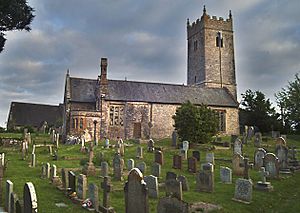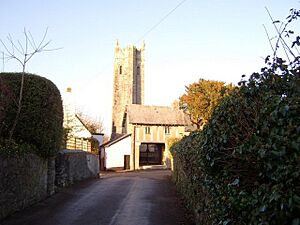Church of St Mary the Virgin, Bickington facts for kids
Quick facts for kids Church of St Mary the Virgin |
|
|---|---|

North face of Bickington Village Church
|
|
| 50°32′29″N 3°41′43″W / 50.5415°N 3.6953°W | |
| Location | Bickington, Devon |
| Country | England |
| Denomination | Church of England |
| History | |
| Founded | 1443 |
| Architecture | |
| Heritage designation | Listed Building Grade I |
| Administration | |
| Parish | Ashburton St Andrew |
| Diocese | Exeter |
The Church of St Mary the Virgin is a historic church located in Bickington, Devon, England. It was built in the 15th century and is part of the Church of England. This church is considered very important, which is why its building has a special Grade I listing.
Contents
A Look Back in Time: Church History
The Church of St Mary the Virgin has a long history. It was first mentioned in official records in 1420. At that time, it was known as a "daughter church" of Ashburton. This means it was a smaller church connected to a larger, main church.
Early Beginnings
People believe the church might be built on a very old Christian burial ground. This burial ground could even be from before the Normans came to England in 1066! Clues for this idea include an old lane that bends around the church and the churchyard itself, which is shaped like a circle and raised up.
The church building you see today was mostly built in 1443. The north aisle, which is a side part of the church, was added in the 16th century. There are also mentions of an even older church that stood here before the current one.
Who Helped Build It?
It's not fully known who paid for the church to be built in Bickington. Some large houses from that time, like East Burn, Herebere, and Ramshorn, had fancy carved fireplaces. This suggests that the families living there had enough money to help with such a big project. It's likely that people like Thomas Shabbetour and John Majour also helped. Building a church, even a small one, cost a lot of money back then!
Changes Over the Years
In 1842, Bickington became its own separate parish. This meant it had its own church leader, called a vicar. However, in 1952, the church was reunited with Ashburton. The vicar's house was sold, and the church once again became a "daughter church" of Ashburton in 2006.
The church building was greatly repaired and updated in 1884. At the same time, a new vicarage (vicar's house) was built where an old 15th-century house used to be. All these repairs and the new house cost about £2,114.
Church Design and Art
The church is built from limestone. It has a strong tower with two levels and pointed decorations called pinnacles. There's also a small tower with stairs on the south side. During the 1884 repairs, the outside of the church and all the south walls were rebuilt.
Many of the beautiful carvings inside the church were done by Harry Hems from Exeter. He carved the lectern (where the Bible is read) and the credence table (a small table used during services). The amazing carving behind the altar, called the Reredos, was designed by R. Medley Fulford. It was a gift from Reverend William Smith, who was the vicar in 1887.
The original screen, which separated parts of the church, was taken down in 1825. Only a few pieces remain. Some of these pieces have special "linen fold" carvings. These old pieces were used in the sedilia (seats for priests) and in the newer low screen and choir stalls. A part of the screen also goes across the north chapel, which is known as the "Wrigwell Pew." The Bickford family, who owned land in Bickington for 600 years, have many memorials to them around the church.
The Church of St Mary the Virgin was officially recognized as a Grade I listed building in 1955. This means it is a very important historical building that needs to be protected.
The Lych Gate
On the south side of the church, there is a special gate called a lych gate. This gate dates back to the 15th century and was rebuilt in 1901. Reverend R. M. Fulford designed it to look as much like the original as possible. The old carved wooden beams were kept, but everything else was replaced.
On one side of the gate, there's a small room on the ground floor. Above it, there's another room reached by stairs. This upper room has been used for many different things over the years. It has housed poor people from the village, served as a changing room for the priest, and been a meeting place for groups like the Mothers Union and the church council. It was even used as a youth club and a cobbler's shop!
The Church Bells
In 1553, records show that the church tower had "111 belles." This was likely a way of saying "many bells."
Two of the church bells were remade in the 17th century. In 1960, all the bells were checked, retuned, and rehung in a new wooden frame. This work was done by John Taylor of Loughborough. The fifth tenor bell has a special crowned top.
Here are the bells in the tower:
- Tenor Bell: Made for Scobell Nicholas Harell, Church Warden, in 1664.
- Fifth Bell: Says "Soli DeoDevtr Gloria I.P. Exon" and was made in 1664. This means "To God alone be the glory."
- Fourth Bell: Cast by John Warner and Sons in 1774 and remade in 1888 when W. Smith was Vicar.
- Third Bell: Made in 1887.
- Second Bell: Cast by John Warner, London, in 1888 when W. Smith was Vicar.
- Treble Bell: Cast by Mears and Stainbank, P H 0 Presbyter, between 1906 and 1908.


